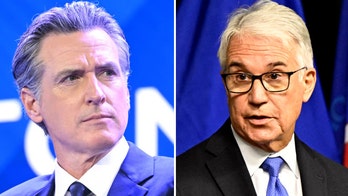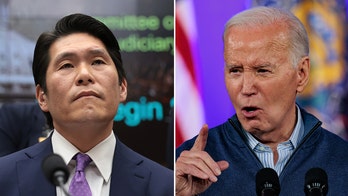As negotiators look to gimmicks and changing assumptions to reach a deal on raising the debt ceiling, a new report by congressional budgeters out Wednesday is offering a grim outlook and ugly alternatives for dealing with increasing debt.
The report by the Congressional Budget Office says that the debt will eat up the government’s spending ability, and offers two scenarios -- both potential trajectories -- that they say by 2035 will push the debt either to most of the annual gross domestic product or to nearly twice the economic power of the U.S.
Already, the CBO says, the debt has spiraled out of control in just three years.
"At the end of 2008, that debt equaled 40 percent of the nation's annual economic output (a little above the 40-year average of 37 percent). Since then, the figure has shot upward: By the end of this year, the Congressional Budget Office (CBO) projects, federal debt will reach roughly 70 percent of gross domestic product (GDP) -- the highest percentage since shortly after World War II," reads the report.
According to CBO, the government has two paths it can take -- an extended baseline scenario, better known as the course the government is currently on; or an alternative fiscal scenario, which would entail lawmakers torquing the system.
By CBO's account, neither scenario sounds promising, and neither addresses potential changes to Social Security or Medicare outside the coming health care law.
Under the first scenario, the federal government would need to accumulate 23 percent of GDP by 2035 in order to limit the federal debt to the equivalent of 84 percent of GDP.
To do would mean letting the Bush-era tax cuts expire, extending the alternative minimum tax to lower income levels, reducing payments to doctors under Medicare as scheduled and bringing in taxes as envisioned by the new health care law.
"That significant increase in revenues and decrease in the relative magnitude of other spending would offset much -- though not all -- of the rise in spending on health care programs and Social Security," the report reads. "With both debt and interest rates rising over time, interest payments, which absorb federal resources that could otherwise be used to pay for government services, would climb to 4 percent of GDP (or one-sixth of federal revenues) by 2035, compared with about 1 percent now."
The alternative plan is much "bleaker," say CBO budgeters, because it assumes the government will keep revenues "near their historical average of 18 percent of GDP." That would come with extending Bush-era rates, an AMT fix and tweaks to tax law.
It also assumes that changes in the health care law intended "to restrain growth in federal health care spending will not continue in effect after 2021," and it assumes lawmakers will not decrease discretionary spending as much as is needed.
"With significantly lower revenues and higher outlays, debt held by the public would exceed 100 percent of GDP by 2021. After that, the growing imbalance between revenues and spending, combined with spiraling interest payments, would swiftly push debt to higher and higher levels. Debt as a share of GDP would exceed its historical peak of 109 percent by 2023 and would approach 190 percent in 2035," the report reads.
To CBO, the alternative fiscal scenario "presents a more realistic picture" of what's to come and "underscores the need for large and rapid policy changes to put the nation on a sustainable
fiscal course."
"To keep deficits and debt from climbing to unsustainable levels, policymakers will need to increase revenues substantially as a percentage of GDP, decrease spending significantly from projected levels, or adopt some combination of those two approaches," CBO concluded
In both scenarios, Congress does not address changes to entitlement programs outside the health care law that passed last year.
The new numbers come as negotiators in Washington look to for a budget deal to satisfy lawmakers reluctant to raise the debt limit without spending reforms. Vice President Joe Biden has been leading the negotiations, but ideological differences have left negotiators with few areas of agreement.
In all, the hope is to cut deficits by about $4 trillion to $5 trillion in the long-term with $1 trillion to $2 trillion right away. But with an impasse resistant to compromise, Washington may turn to the usual shell games -- possibly inflating savings from troop drawdowns in Iraq and Afghanistan and stretching the budget savings over 12 years rather than the traditional 10 used by congressional budgeters to project future funding.
"I think it's the triumph of hope over experience," Sen. John Thune, R-S.C., said of the discussions. "We're all hopeful they're going to yield a result. I think that it's going to be a very heavy lift probably to get the types of things that many of us would like to see come out of this."
Thune said Republicans could accept "something on spending in the near term" as well as longer-term caps on spending "in the out years" and some entitlement reform. He added that the budget could be dialed back to 2008 levels, a spending year that was in deficit even before the massive add-ons by the Obama administration.
"If you look at how much spending has gone up just in the last couple of years, it went up 24 percent in the last two years, at a time when inflation was 2 percent," he said. "So, if you go back to that level, you can achieve a lot of savings in the near term. But, in order to get, you know, to really solve the country's fiscal problems, you have got to take on entitlements, and the president's acknowledged that. He just hasn't been willing to put anything on the table today."
But Sen. Tom Harkin, D-Iowa, said on the Senate floor Wednesday that balance is required to reduce deficits, and that includes raising taxes. Harkin said that opponents of tax increases assume that the country is broke and industry and wealthy Americans can't afford to pay more to keep government operating at its current projections.
"I reject that. We are not broke, we are not poor. The United States of America is the richest nation in the history of mankind," he said. "So if we're so rich, why are we so broke, why are we so poor?
"And the answer is because the system is broke," Harkin said, attributing the meltdown to "massive tax cuts" under the Bush administration.
By all accounts, something needs to be done. A Bloomberg national poll out Tuesday found that fewer than a quarter of respondents see signs of improvement in the economy, while 66 percent say the country is on the wrong track.
The poll conducted June 17-20 also found that by a 44 percent to 34 percent margin, Americans say they are worse off than when President Obama took office in January 2009. And a majority expect their children to have a tougher time than they did.
"That, plus two unpaid-for wars, an unpaid for Medicare benefit put us into the hole, put us into the greatest deficit and the biggest debt we've ever had in the nation," Harkin said.
CBO warned that any actions in the short term to reduce the debt are likely to hurt economic recovery but "the sooner they are carried out once the economy recovers, the smaller will be the damage to the economy from growing federal debt."
Sen. Kent Conrad, D-N.D., the retiring chairman of the Senate Budget Committee, said the CBO report shows that the debt negotiators cannot limit their choices to spending cuts alone, and cited suggestions from President Obama's fiscal commission whose recommendations last year couldn't even reach the threshold for approval by a supermajority of the panel's 18 members.
"The fiscal commission plan took a balanced approach, with discretionary spending cuts, including defense; entitlement changes; and tax reform that raises revenue. Both Democrats and Republicans had to move off of their fixed positions and make concessions in order to reach an agreement. That is what is needed to truly put the country back on a sound fiscal course," he said.





